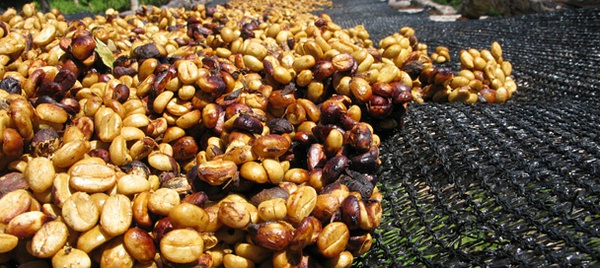Process and characteristics of wet planing treatment of raw coffee beans the surface of raw coffee beans in Manning looks moldy
Sumatra wet planing method
Every year from March to May and September to December is the Sumatra harvest season for Manning, and now most coffee farmers only harvest all-red coffee cherries. After collecting coffee cherries in the morning, coffee cherries will be peeled and peeled in the afternoon. Sumatra has a superior natural environment, and most of the water used will be mountain spring water.
1. Peel the coffee fruit, put the shell beans into a vat or sink filled with water, and remove the defective shell beans floating on the liquid surface.
2. Wash the dense shell beans sunk to the bottom of the water slightly, put them into a bucket or plastic bag, and do a little dry body fermentation, that is, to ferment and flavor the pectin sugar on the surface of the seed shell. Basically, the longer the fermentation time, the more sour. The fermentation time varies from person to person, generally only a few hours, but some manors omit the dry body fermentation stage and directly expose the shell beans, which can always be sour and improve the sticky taste, so that the pectin sugar can be fully fermented to increase the flavor, usually between 12-36 hours, depending on the specific situation.
3. When the bean with shell is exposed to the sun for one or two days, the moisture content of the bean body is 30% 50%, and the bean body is still semi-hard and semi-soft. Wipe off the seed shell with a shell planer to speed up the drying process. After about two days, the moisture content of the bean reaches 12% Mui 13%. The coffee beans will be collected into a woven bag, usually 40 kg and 80 kg each, and will be sent to the coffee processing factory for shelling, and the success will be completed in about four days.
The shelling process is to grind off the bean shell with a shell planer and then dry it until the moisture content reaches about 12% to 15%. The coffee beans are then sent for machine selection to remove a variety of impurities and then sorted by particle size. Of course, accidents can happen. In the shell planing process, the coffee bean temperature will rise to 30-60 degrees, and completely destroy the parchment, which is likely to trigger the bean sprouting. Wet planing will also occur because the peel is removed in the production process, and the beans come into direct contact with the air, so defective beans such as mildew beans are much higher than water washing and sun drying.
Mold brings good flavor.
Because coffee beans have four layers of protection-pericarp, pectin, seed shell, silver skin. In the washing method, only the first two layers were removed, and the seed shell and silver coat were preserved and dried in the sun. On the other hand, the wet planing method cuts off the third and fourth layers of protection, that is, the falling body is sunbathed, which is why the raw Sumatran beans are turquoise. Although the wet planing method shortens the drying time, the probability of being unmanned by molds, fungi and yeasts is also greatly increased.
Interestingly, pollution is not a bad thing, depending on the strain. Dr. Martha Donniva of the Brazilian Institute of Food Science and Technology has tried to use different strains of touching coffee beans to produce different flavors, including decay, fuel consumption, mildew, wood, iodine, caramel, chocolate and floral aromas. Scholars believe that the wood flavor, immortal grass flavor, earth flavor, banana flavor and spice flavor of Sumatran coffee should be made by mold. The director of the baking plant often reflects to the academic community that some coffee beans infected with mold have a better flavor after being cleaned, but some are difficult to import and are related to bacteria. It may be possible to suppress bad mold and implant good mold, just as winology calls "controlling savage yeasts" and "cultivating elegant yeasts". But which molds help to enhance the flavor of coffee? Which are bad bacteria? It needs to be further studied.
The rate of sheep's foot bean is high.
The wet planing method may touch the germination mechanism of raw beans and then affect the flavor. Because coffee beans that run out of four layers of protection are in a state of falling body, which is much more likely to trigger sprouting than washing beans with only two layers of protection, that is, activating the metabolism of sugars, proteins and fats, all of which are precursors of coffee aromatics. In addition, the friction of coffee beans in the shell planing process, the bean body heating up to 30 ℃-60 ℃, is also conducive to sprouting and mold growth. And the semi-hard and semi-soft wet raw beans are easily crushed by mechanical force when removing the seed shell, and the beans are easy to crack like a sheep's hoof, which is why there is a high ratio of sheep's hoof beans in Sumatra. However, it is still inconclusive whether the bauhinia bean is good or bad.
He said with a smile: "with proper control, it is full of fruity and sweetness." The focus of control is to keep the utensils and beans clean. Once the shell is planed, it needs to dry quickly to produce a mellow, low-acid and sweet taste of Sumatra; if not controlled properly, it may produce a boring Sumatra or even moldy smell. If you like the sour taste, Yachi can also wash it, depending on the needs of customers. "

Important Notice :
前街咖啡 FrontStreet Coffee has moved to new addredd:
FrontStreet Coffee Address: 315,Donghua East Road,GuangZhou
Tel:020 38364473
- Prev

Baristas must know that wet planing coffee is a must-drink gold manning
The wet planing method also allows beans to come into direct contact with the air because the seed shells are shaved off in the production process, and the chances of coffee beans being contaminated by molds and fungi are also greatly increased. Improper management and control in the production process may cause coffee beans to be boring or have a bad flavor. Defective beans such as moldy beans are much higher than the widely used methods of washing and tanning. 1. Peel the coffee fruit and put the shelled beans into a vat or sink filled with water.
- Next

The difference between water washing treatment and sun treatment of raw coffee beans
For a coffee bean, is it better to wash in water than in the sun, or is it better in the sun than in water? At least before I know it, I disdain to wash beans with water. I always feel that the sun is better than washing, and the sun is a little higher. So, in fact, it is a matter of opinion which is better for the two kinds of raw coffee beans. The editor would also like to introduce to you this time.
Related
- What is the meaning of lactic acid fermentation with coffee bean treatment?
- How to judge the state of foam by sound?
- How does the latte pull out the unicorn pattern? Come to get for a little trick to improve the flower pull!
- Will flower pulling affect the taste of the latte?
- Do you know the history of coffee?
- The difference between honey treatment and sun washing what is raisin honey treatment?
- What kind of milk can a novice use to make coffee foam to keep the foam longer? The correct method and skills of milking tutorial sharing
- Why do washed coffee beans taste sour? Flavor characteristics of washed Coffee
- Introduction to the skill of how to practice the size and height of water injection around the circle of hand-brewed coffee
- How do beginners practice coffee flower drawing from scratch?

